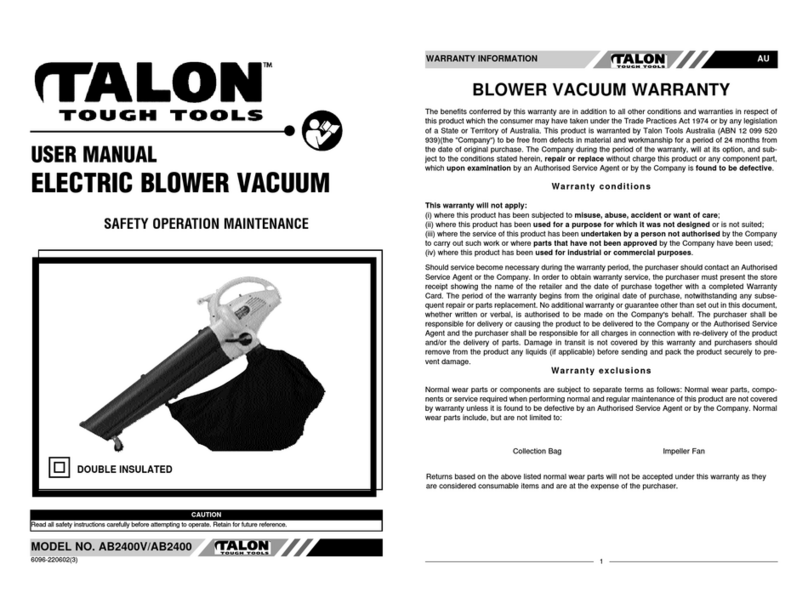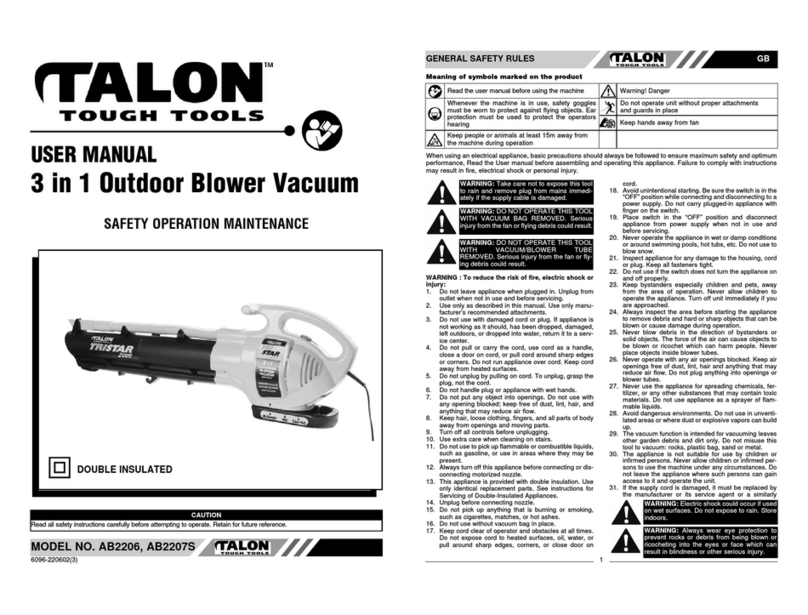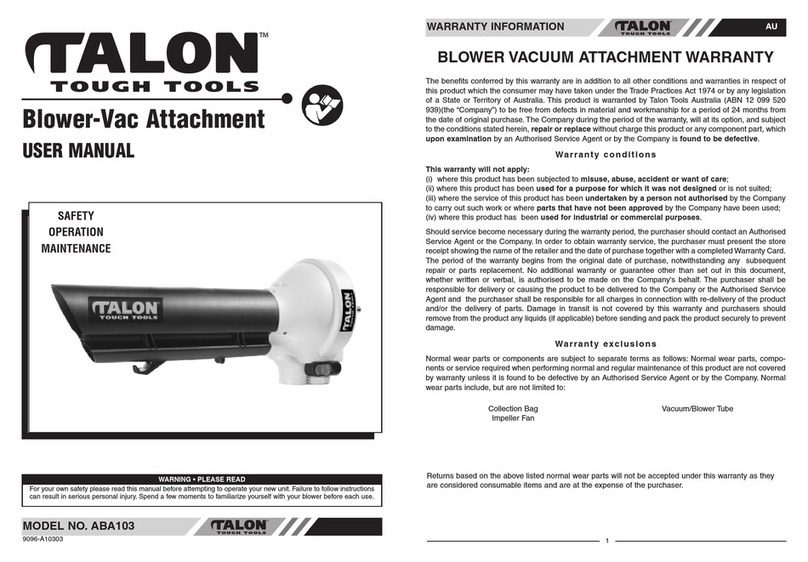RULES FOR SAFE OPERATION AU
OTHER SAFETY WARNINGS
•Always disconnect the spark plug before
performing maintenance or accessing movable
parts.
• Never store the unit, with fuel in the tank, inside a
building where fumes may reach an open flame (pilot
lights, etc.) or sparks (switches, electrical motors,
etc.).
• Allow the engine to cool before storing or
transporting. Be sure to secure the unit while
transporting.
• Store the unit in a dry place, secured, or at a height
to prevent unauthorized use or damage. Keep out
of the reach of children.
• Never douse or squirt the unit with water or any
other liquid. Keep handles dry, clean, and free from
debris. Clean after each use, see Cleaning and
Storage
instructions.
• Keep these instructions. Refer to them often and
use them to instruct other users. If you loan this
unit to
others, also loan these instructions to them.
SPECIAL NOTE: Exposure to vibrations through
prolonged use of petrol powered hand tools could
cause blood vessel or nerve damage in the fingers,
hands, and joints of people prone to circulation
disorders or abnormal swelling. Prolonged use in cold
weather has been linked to blood vessel damage in
otherwise healthy people. If symptoms occur such as
numbness, pain, loss of strength, change in skin color
or texture, or loss of feeling in the fingers, hands or
joints, discontinue use of this tool and seek medical
attention. An anti-vibration system does not guarantee
avoidance of these problems. Users who operate power
tools on a regular basis must closely monitor their
physical condition and the condition of this tool.
SAVE THESE INSTRUCTIONS
RULES FOR SAFE OPERATION AU
45
WHILE OPERATING
• Never start or run the unit inside a closed room or
building. Breathing exhaust fumes can kill. Operate
this unit only in a well-ventilated outdoor area.
• Wear safety glasses or goggles that are marked as
meeting Australian standards and are marked as
such. Wear ear/hearing protection when operating
this unit.
• Never run the unit without the the proper equipment
attached. When using this unit, always install the
blower tubes depending on blower application.
•To reduce the risk of hearing loss associated with
sound level(s), always wear ear/hearing protection
when operating this unit.
•Wear heavy long pants, boots, gloves, and a long
sleeve shirt. Do not wear loose clothing, jewellery,
short pants, sandals, or go barefoot. Secure hair
above shoulder level.
• To avoid static electricity shock, do not wear rubber
gloves or any other insulated gloves while operating
this unit.
• Use the unit only in daylight or good artificial light.
• Keep outside surfaces free from oil and fuel.
• Avoid accidental starting. Be in the starting position
whenever pulling the starter rope. The operator and
unit must be in a stable position while starting.
Refer to Starting/Stopping Instructions.
•Do not set unit on any surface except a clean, hard
area while engine is running. Debris such as gravel,
sand, dust, grass, etc. could be picked up by the
air intake and thrown out by the discharge opening,
damaging unit, property, or causing serious injury to
bystanders or operator.
• Use the right tool. Only use this tool for its intended
purpose.
• Do not force unit. It will do the job better and with
less likelihood of injury at a rate for which it was
designed.
•Do not overreach or use from unstable surfaces
such as ladders, trees, steep slopes, rooftops, etc.
Always keep proper footing and balance.
•Always hold the unit with a firm grip when
operating.
• Keep hands, face, and feet away from all moving
parts. Do not touch or try to stop the impeller when it
is rotating. Do not operate without guards in place.
• Do not put any object into openings. Do not use
with any opening blocked; keep free of dirt, debris,
and
anything that may reduce the air flow.
•Do not touch the engine or muffler. These parts get
extremely hot from operation, even after the unit is
turned off.
•Do not operate the engine faster than the speed
needed to do the job. Do not run the engine at high
speed when not in use.
• Always stop the engine when operation is delayed
or when walking from one location to another.
• Stop the engine for maintenance, repair, to install or
remove the blower tubes attachments. The unit
must be stopped and the impeller no longer turning
to avoid contact with the rotating blades.
• If you strike or come into contact with a foreign
object, stop the engine immediately and check for
damage. Do not operate before repairing damage.
Do not operate the unit with loose or damaged
parts.
•Use only original equipment manufacturer
replacement parts when servicing this unit. These
parts are available from your authorised service
dealer. Do not use unauthorized parts, accessories,
or attachments for this unit. Doing so could lead to
serious injury to the user, or damage to the unit,
and void your warranty.
•Never use this unit for spreading chemicals,
fertilizers or other substances which may contain
toxic materials.
• To reduce fire hazard, replace faulty muffler. Keep
the engine and muffler free from grass, leaves,
excessive grease or carbon build up.
• Turn the engine off and disconnect the spark plug
for maintenance or repair.
•Never point the blower or blowing debris in the
direction of people, animals or in the direction of
windows. Always direct the blowing debris away
from people, animals, and windows. Use extra
caution when blowing debris near solid objects
such as trees, automobiles, walls, etc.





























